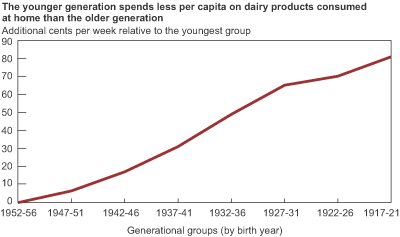Got Milk? Implications of Generational and Aging Effects
- by Noel Blisard
- 2/1/2004
As people age, their eating patterns change. The dishes of youth—foot-long hotdogs, spicy Buffalo wings, and beer—are often replaced by broiled fish, baked potatoes, and high-bran cereal as a person’s metabolism slows and health concerns become more central to well-being.
Generational effects also shape food choices. People born during the 1920s and 1930s generally grew up eating more typical “American fare”—eggs for breakfast, sandwiches for lunch, and pot roasts for dinner. Younger generations have had more exposure in their early years to McDonald’s Happy Meals and the cuisines of Southeast Asia and Latin America brought by America’s more recent immigrants. “Generation X” tends to eat away from home more often than their grandparents do.
Aging and generational effects can influence spending on specific food groups. ERS researchers looked at the impact of both of these effects on per capita spending for milk, cheese, ice cream, and other dairy products bought in supermarkets, convenience stores, and other food stores. They found that both the aging of the U.S. population and the succession of the generations are working against at-home spending on dairy products.
Per capita, at-home spending on dairy products, adjusted for inflation, was estimated for eight generational groups, starting with group 1, who were 26-30 years old in 1982, and ending with group 8, who were 61-65 years old in the same year. The analysis followed each generational group over time, ending in 1995. In addition, we included 14 age intervals (ages 26-65) in the analysis to capture the aging effect independently from the generational effect.
The research found that older generations spend more on dairy products consumed at home than their children and grandchildren. For example, the second group spent about 6 cents more per capita per week than group 1, while the oldest group spent about 80 cents more. The effect of aging was common to all generational groups. Per capita, at-home spending on dairy products falls as people age: compared with a 26-year old, those age 32-35 spend about 16 cents less per capita per week for dairy products, while those 65 and older spend about 58 cents less.
Taken together, these findings indicate that per capita, at-home spending on dairy products is likely to continue to decline. Population changes and food spending trends in the away-from-home-market must be examined to determine how total spending on dairy products in the U.S. will change over time.
This article is drawn from:
- Blisard, N. (2001). Income and Food Expenditures Decomposed by Cohort, Age, and Time Effects. U.S. Department of Agriculture, Economic Research Service. TB-1896.


